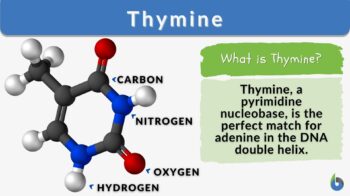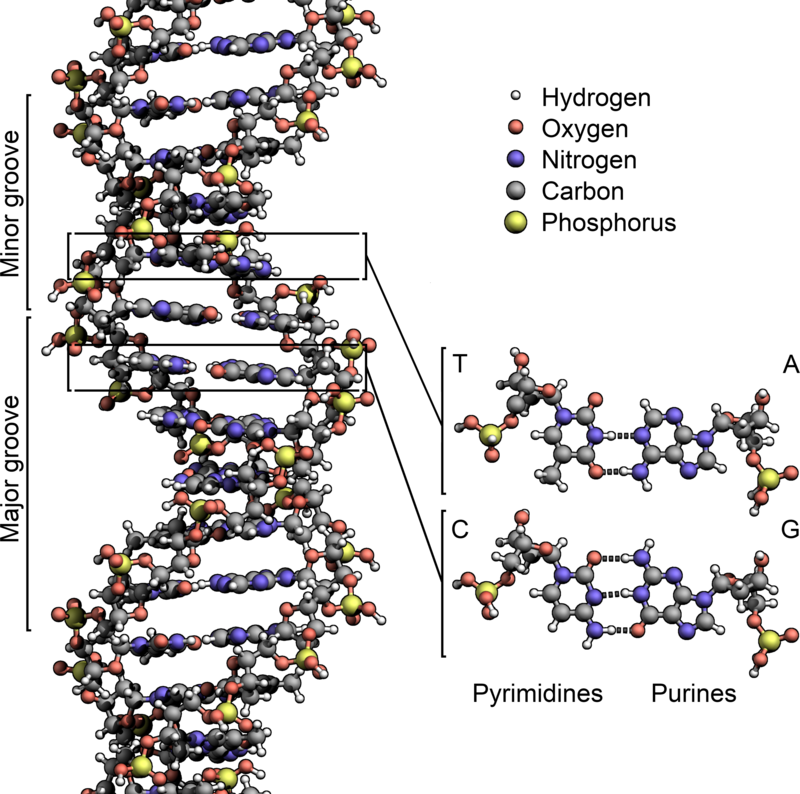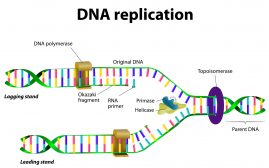
Thymine
n., plural:
/ˈθaɪmin/
Definition: DNA base pairing component
Table of Contents
Thymine Definition
A thymine is a pyrimidine nucleobase in the DNA molecule that complementary pairs with adenine. It has a chemical formula of C5H6N2O2. Thymine is a crucial component of nucleic acids, including DNA (deoxyribonucleic acid). It is one of the four nitrogenous bases that make up the genetic code that determines the trait or phenotype of an organism. Thymine is often abbreviated as “T”.
Thymine as a nucleobase
Nucleic acids, such as DNA and RNA, are polymers of monomeric nucleotides. Each nucleotide is made up of phosphoric acid, sugar (5-carbon), and nitrogenous base (or nucleobase). There are five nucleobases that serve as fundamental units of the genetic code: (1) adenine, (2) guanine, (3) cytosine, (4) thymine, and (5) uracil. These nitrogenous bases may be classified into purines and pyrimidines. Thymine is a pyrimidine nucleobase.
Properties of thymine
- Thymine is a pyrimidine nucleobase with a chemical formula of C5H6N2O2. A pyrimidine is a heterocyclic aromatic organic compound with a single ring (called a pyrimidine ring) with alternating carbon and nitrogen atoms. The chemical structure of thymine involves both aromatic and ketone functional groups.
- Thymine has a molar mass of 126.115 g/mol and a melting point of 316 to 317 °C.
- Thymine may occur as a component of a nucleoside (nucleobase + sugar deoxyribose or ribose) or a component of a nucleotide (nucleoside with phosphate groups).
- Thymine is one of the five primary (canonical) nucleobases in nucleic acid structures, particularly DNA. In RNA though, thymine is replaced by uracil. Both thymine and uracil complementary pairs with adenine. In particular, thymine forms two hydrogen bonds with adenine.
Historical significance
The term “thymine” reflects its association with the thymus gland. In 1893, Ludwig Karl Martin Leonhard Albrecht Kossel and Albert Neumann described and isolated thymine from calf thymus glands, thus, the name. (Kossel & Neumann, 1893)
NOTE IT!
The isolation and naming of the five nucleobases, including thymine, is attributed to Albrecht Kossel (a German biochemist). From 1885 to 1901, he and his students discovered them through chemical analyses of the nucleic acids.3
Thymine vs. Uracil vs. Cytosine
Thymine, cytosine, and uracil are pyrimidine nucleobases. Thymine has two keto groups at positions 2 and 4, and a methyl group at position 5 in its heterocyclic aromatic ring. Thymine complementary base pairs with adenine by two hydrogen bonds. However, unlike cytosine which is present in both DNA and RNA, thymine is present only in the DNA molecule because uracil takes its place in RNA. Uracil is similar to thymine in terms of structure except for the methyl group at position 5 in the heterocyclic aromatic ring present in thymine.
One of the possible explanations why DNA has thymine instead of uracil is associated with the conversion of cytosine into uracil by spontaneous deamination. Cytosine can turn into uracil when it loses its amine group. This deamination of cytosine is a common occurrence. Nevertheless, the error is corrected through an inherent DNA repair system. If not repaired though, it could lead to a point mutation.
Had uracil been present in the DNA, the repair systems might not be able to distinguish the original uracil from the cytosine-turned-uracil and therefore may fail to discern which uracil to correct.
The presence of methyl group in thymine (which is absent in uracil) helps avert this from happening, thereby, preserving the integrity and stability of the genetic code.
Cytosine differs from thymine and uracil by having a keto group at position 2 and an amine group at position 4 in its heterocyclic aromatic ring. It has a chemical formula of C4H5N3O. Cytosine complementary pairs with guanine in both DNA and RNA as opposed to thymine and uracil which pairs up with adenine in DNA and RNA, respectively.
The 4 Nucleotide Bases: Guanine, Cytosine, Adenine, and Thymine (by PremedHQ Science Academy):
Biology definition:
A thymine is a pyrimidine nucleobase that, as a constituent of DNA, plays a crucial role in genetic information storage and transfer.
Etymology: The term “thymine” is derived from the Greek word “thumos,” meaning “spirit” or “soul,” due to its association with thymus glands.
Also called: 5-methyl uracil
IUPAC name: 5-Methylpyrimidine-2,4(1H,3H)-dione
Chemical formula: C5H6N2O2
Abbreviation: T; Thy
Biological Functions
Thymine is one of the five primary (or canonical) nucleobases; the others are cytosine, uracil, guanine, and adenine. They are the fundamental nucleobases that make up the nucleic acid. Nucleic acids hold an important role in cellular functions, heredity, and the survival of an organism. The role of thymine bases in DNA is to confer structural stability by pairing with adenine through hydrogen bonds (as cytosine pairs with guanine). This consistency in pairing is essential for DNA replication and the integrity of the genetic code that holds the instructions for the synthesis of proteins and other cellular components.
Thymine is also an essential component of nucleotides. A nucleotide containing thymine, deoxyribose, and one phosphate group form thymidine monophosphate (TMP). If with two phosphates, then, it is referred to as thymidine diphosphate (TDP), or if with three, then, thymidine triphosphate (TTP).

Medically, thymine is a metabolic analog that has been utilized in the treatment of certain diseases, including cancer, by disrupting DNA synthesis in rapidly dividing cells.
Thymine Synthesis
Thymine, similar to other pyrimidines, is formed from a series of steps, beginning with the formation of carbamoyl phosphate.
- Carbamoyl phosphate forms from a reaction involving bicarbonate, glutamine, ATP, and water molecules. This process is catalyzed by the enzyme carbamoyl phosphate synthetase.
- The carbamoyl phosphate is then converted into carbamoyl aspartate through the catalytic activity of aspartate transcarbamylase.
- Carbamoyl aspartate is next converted into dihydroorotate, which is then oxidized to produce orotate.
- 5-phospho-α-D-ribosyl 1-pyrophosphate (PRPP), a ribose phosphate, reacts to orotate to form orotidine-5-monophosphate (OMP).
- OMP is decarboxylated by the enzyme OMP decarboxylase to yield uridine monophosphate (UMP).
- Eventually, uridine diphosphate (UDP) and uridine triphosphate (UTP) are produced down the biosynthetic pathway by kinases and dephosphorylation of ATPs.2
- In order to synthesize thymidine, uridine is reduced first to deoxyuridine (by the enzyme ribonucleotide reductase). After which, it is methylated by the enzyme thymidylate synthase to form thymidine.
Thymine Degradation
Thymine may be degraded as follows: thymine » β-amino isobutyrate» » Citric acid cycle. Thymine may be recycled by a salvage pathway. In brief, thymine is converted into thymidine by reacting with deoxyribose-1-phosphate and by the enzyme thymidine phosphorylase. Thymidine is then converted into thymidine monophosphate by the enzyme nucleoside kinase.
Mutation
Mutation is a change in the nucleotide sequence of a gene or a chromosome. Mutations in the DNA often involve two adjacent thymines. In the presence of UV light, thymine dimers form. This causes kinks in the DNA molecule. As a result, the normal function of the affected DNA may be hindered. When a mutation occurs, repair mechanisms rectify the DNA sequence. One of the ways to correct a mutation involving only a single strand of the DNA is base excision repair (nucleotide excision repair). This repair mechanism works by removing the damaged region and then replacing it using the other strand (i.e. the complementary strand) as the template. Uncorrected thymine dimers may be a factor that increases the risk of developing cancer cells.
References
- Kossel, A., & Neumann, A. (1893). Ueber das Thymin, ein Spaltungsproduct der Nucleïnsäure. Chemische Berichte, 26(3), 2753–2756. https://doi.org/10.1002/cber.18930260379
- Charma, K. & Somani, D. (2015). Pyrimidine Biosynthesis. Retrieved from Slideshare.net website: ://www.slideshare.net/kskuldeep1995/pyrimidine-biosynthesis-46874172 Link
- The Editors of Encyclopedia Britannica. (2018). Albrecht Kossel German biochemist. In Encyclopædia Britannica. Retrieved from https://www.britannica.com/biography/Albrecht-Kossel
©BiologyOnline.com. Content provided and moderated by Biology Online Editors.




